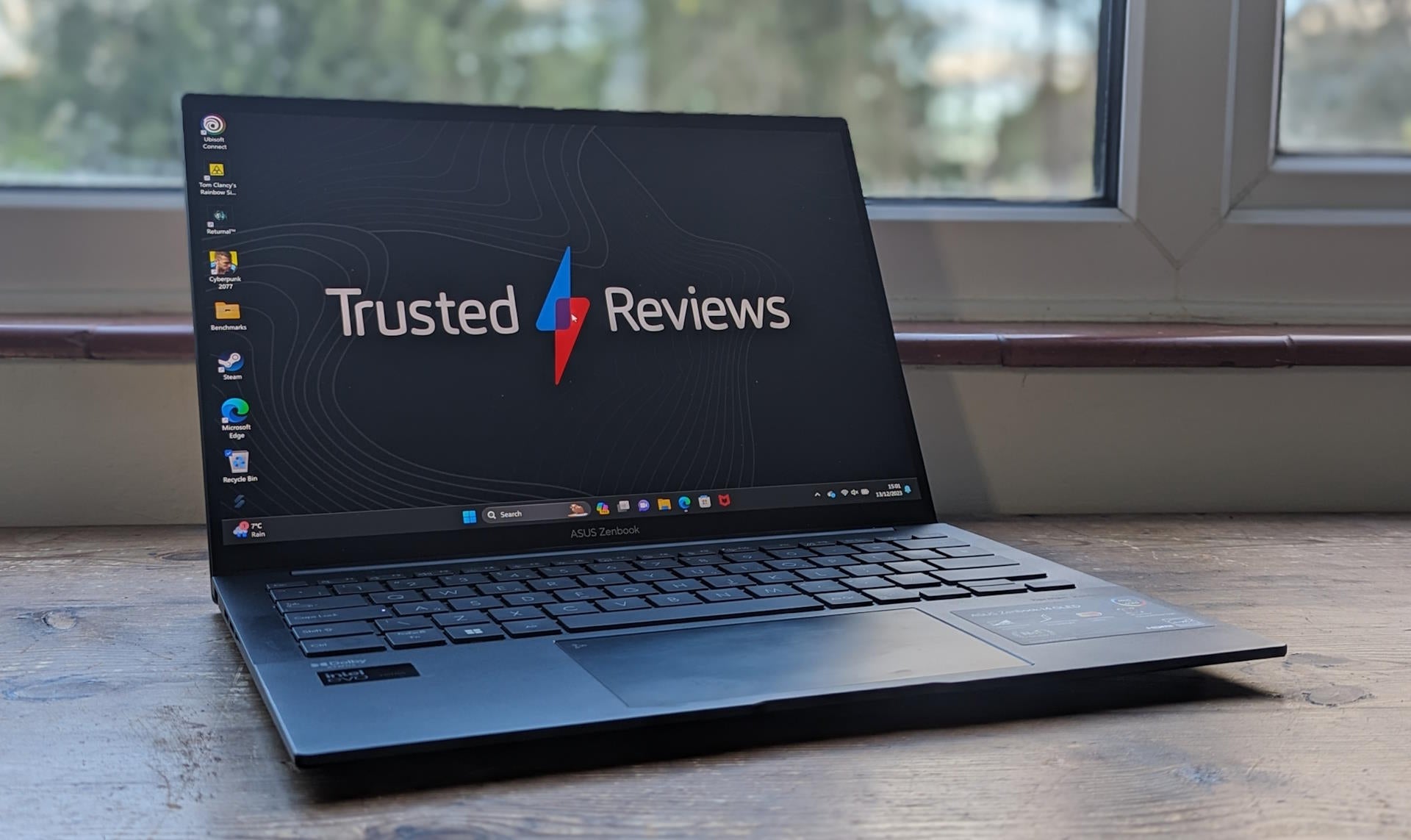Verdict
A fantastic lightweight laptop combining good design, strong performance and an excellent screen. It’s a promising first showcase for Intel’s new Core Ultra range.
Pros
- Great performance in mainstream apps
- Good gaming performance by iGPU standards
- Fantastic OLED screen
- No compromises on the connectivity or ergonomics
Cons
- GPU speeds constrained by slimline form factor
-
High performance in a slim-and-light designIntel’s new Meteor Lake architecture brings higher levels of CPU and GPU performance to ultraportable devices. -
Better graphics from an iGPUWith an Intel Arc GPU on its own tile within the processor, this is the first Intel laptop to deliver gaming-grade performance without a dedicated graphics chip. -
Superb OLED displayWith a high 1800p resolution and brilliant colour reproduction, this OLED screen is perfect for creative applications – or even just games and streaming video.
Introduction
Intel’s Meteor Lake technology is a big deal. Sure, we’ve had some big changes in the last few processor generations, particularly the introduction of Performance and Efficient cores in the 12th-generation Alder Lake CPUs, but Meteor Lake is a real departure from the Intel Core processors we’ve been seeing over the last 14 years. The Asus Zenbook 14 OLED is one of the first laptops to don the new Intel Core Ultra chips.
Not only does it ditch the single monolithic die for a fusion of tiles or chipsets, each covering different functions, but it’s the first Intel architecture to include a neural processing unit (NPU) for accelerating AI workloads, plus a dedicated graphics tile with a dedicated Intel Arc GPU. In doing so, Intel hopes to move away from previous processor families where the focus was all about multi-core CPU performance, and towards a more balanced architecture that can handle more demanding AI and graphics workloads within tighter power budgets and thermal requirements.
With its Core Ultra 7 155H CPU, the new Asus Zenbook 14 OLED is a case in point. This is a slimline 14-inch laptop, about as light and portable as such things get, yet with its 16-core, 22-thread CPU and integrated Arc Xe-LPG integrated GPU it can deliver the kind of performance you need to run demanding creative apps and even games at lower resolutions and detail settings. Pleasingly, Intel hasn’t jacked up the price for this exciting new generation either, with this laptop starting at £1,099.99 for the Core Ultra 5 model and up to £1,399.99 for a Core Ultra 9 specification – with my Core Ultra 7 review model sitting towards the higher end of the middle.
In recent years, buying an Intel-based laptop of this kind without a dedicated GPU has meant accepting compromises around multi-threaded or graphics performance beyond those you’d make using AMD’s APUs or Apple’s Silicon processors. With Meteor Lake, that could be a thing of the past.
Design and Keyboard
- Thin and light design with tough aluminium chassis
- Solid selection of ports and sockets plus Wi-Fi 6E connectivity
- Great keyboard with crisp, clicky action
If you’ve seen previous Asus Zenbook 14 OLED models, you won’t find anything too surprising about this update’s design. It’s a slim 15mm thick unit, barely bigger than its 14-inch OLED screen at 312 x 220mm, and it weighs just 1.29 kg. The casing is an aluminium alloy coated in an attractive, ceramic feel ink-blue finish, and its MIL-STD-810H certified for durability. There’s barely any flex anywhere in the chassis, including the lid, and I can’t imagine it struggling with a life of being stashed in bags and sitting on coffee shop tables. The lid, with its origami fold design, looks great.
Closed, right side view of the Asus Zenbook 14 OLED
Open, right side view of the Asus Zenbook 14 OLED
Open, left side view of the Asus Zenbook 14 OLED
Closed, left side view of the Asus Zenbook 14 OLED
Connectivity is pretty good for such a slimline unit. Given that it charges via USB Type-C, I’d like to see ports on both sides of the laptop rather than two Thunderbolt 4/USB Type-C ports on the right, but you also get a USB 3.2 Gen 1 Type-A port on the left and an HDMI 2.1 output on the right. Right next door, you’ll find the traditional 3.5mm audio socket. Unlike previous generations, there’s no micro SD card slot.
The Zenbook line tends to squeeze decent ergonomics from compact designs, and the new Zenbook 14 OLED carries on the good work. The backlit keyboard makes the most of the space available, with normal-sized, flat-topped keys in a standard layout, with a little shrinkage on the left Shift and Ctrl keys and a weirdly oversized hash key, but nothing that’s interrupted the flow of my typing in any way. The keys don’t wobble under pressure and the action feels tight with a nice, subtle click. The slim design makes it easy to find a comfortable typing position.
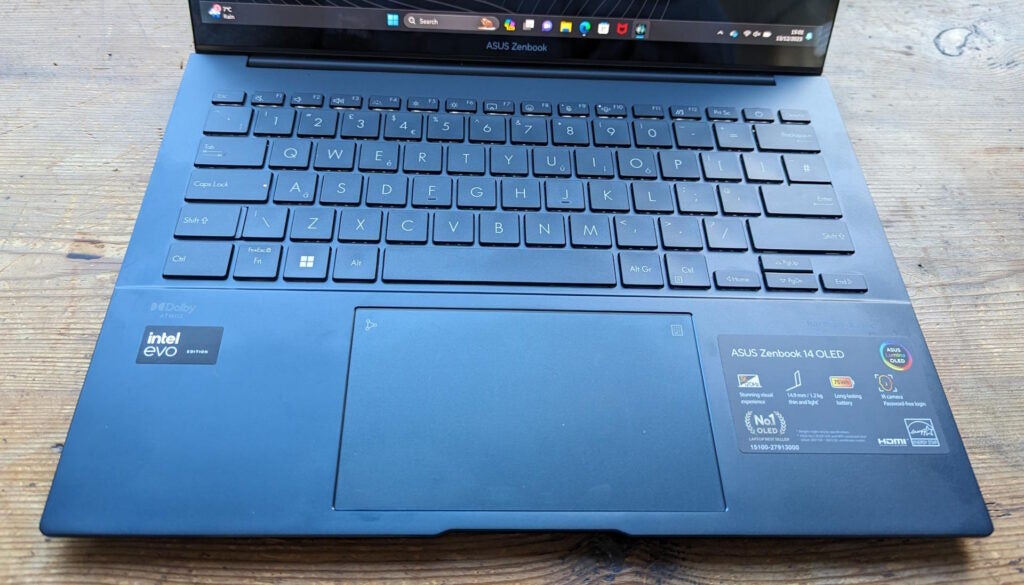
I’ve got plenty of time for the touchpad, too. It feels as smooth as glass, tracking is nigh-on flawless, and it’s big enough to handle some fairly fast or precise work. I’m not such a huge fan of Asus’s NumberPad feature, which transforms the touchpad into a numeric keypad when you touch and hold the symbol in the top-right – I occasionally turn it on by accident and wonder why I keep getting rogue numbers turning up in online forms. Still, it’s easy enough to disable it again when it does.
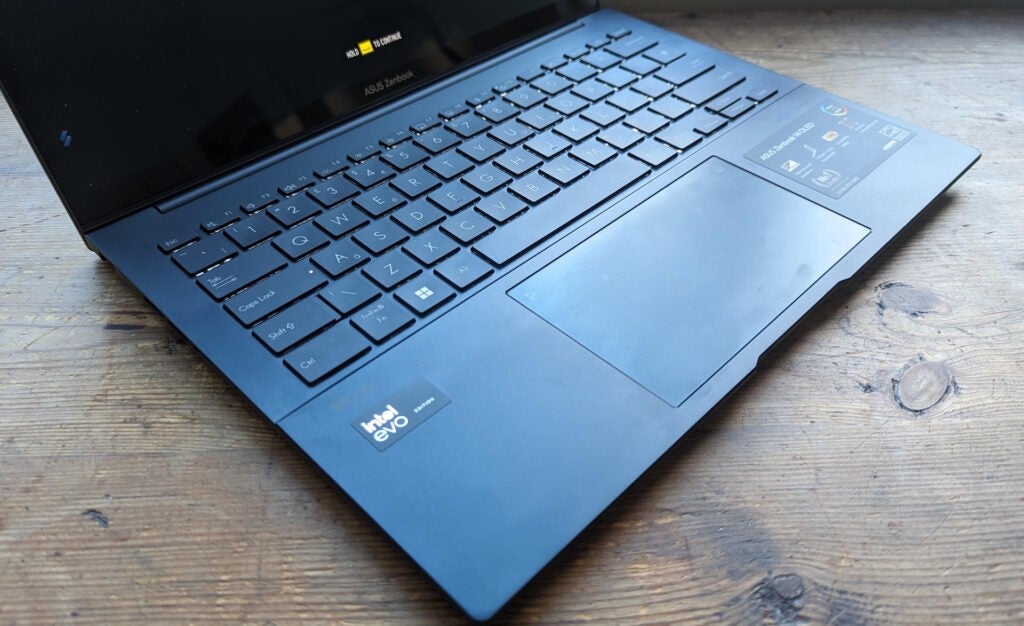
Bar the use of post-consumer recycled plastics in the few areas where plastics are visible, there’s not much of a focus on sustainability with this specific model. However, the packaging is mostly cardboard, so at least that shouldn’t be ending up in landfill.
Display and Sound
- Bright 14in OLED panel with 2880 x 1800 resolution and 120Hz refresh
- Superb contrast and colour reproduction for HDR video and more
- Decent audio at lower volume levels, but loses clarity as the volume goes up
If it weren’t for the next-gen CPU, the display would be the highlight of the Asus Zenbook 14 OLED. It’s a 14-inch OLED panel with a 2880 x 1800 resolution and a 120Hz refresh, and it’s beautifully crisp and vibrant. Colours have a zing you won’t see on most IPS displays, while HDR games and videos look fantastic.
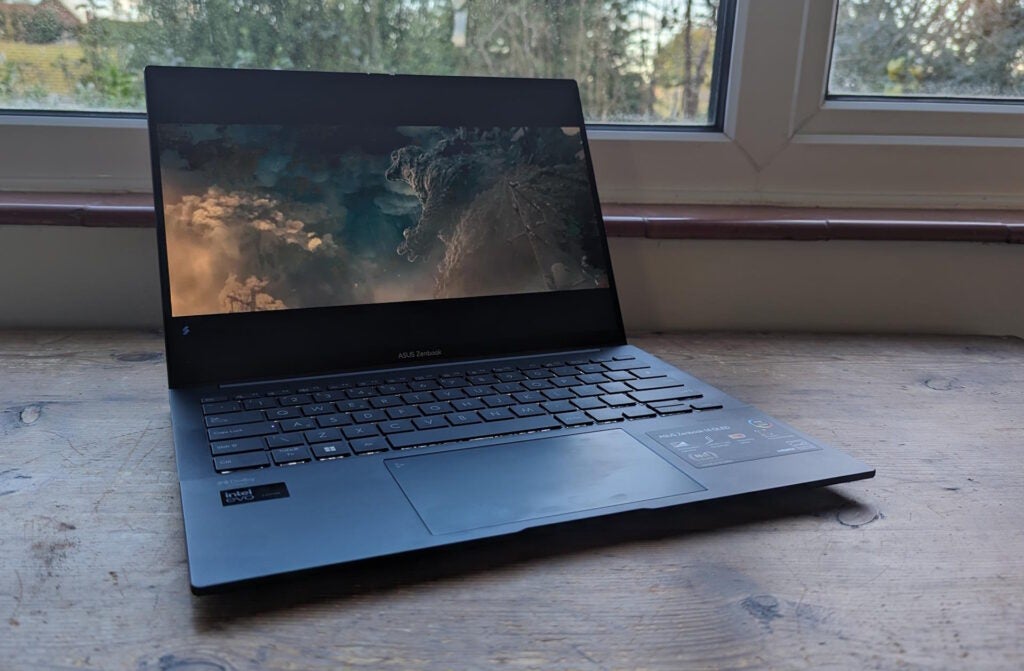
With a colorimeter, I measured SDR brightness levels at 417.2nits, which is bright enough for use anywhere away from direct sunlight, while contrast is technically infinity:1. As for colour reproduction, the screen covers 100% of sRGB, 99.9% of DCI-P3 and 97.6% of Adobe RGB, with volumes of 172.8%, 122% and 119% respectively. In short, it’s more than good enough for high-end video, image-editing and design applications, particularly as colour accuracy is outstanding, with an average Delta-E of just 0.89.
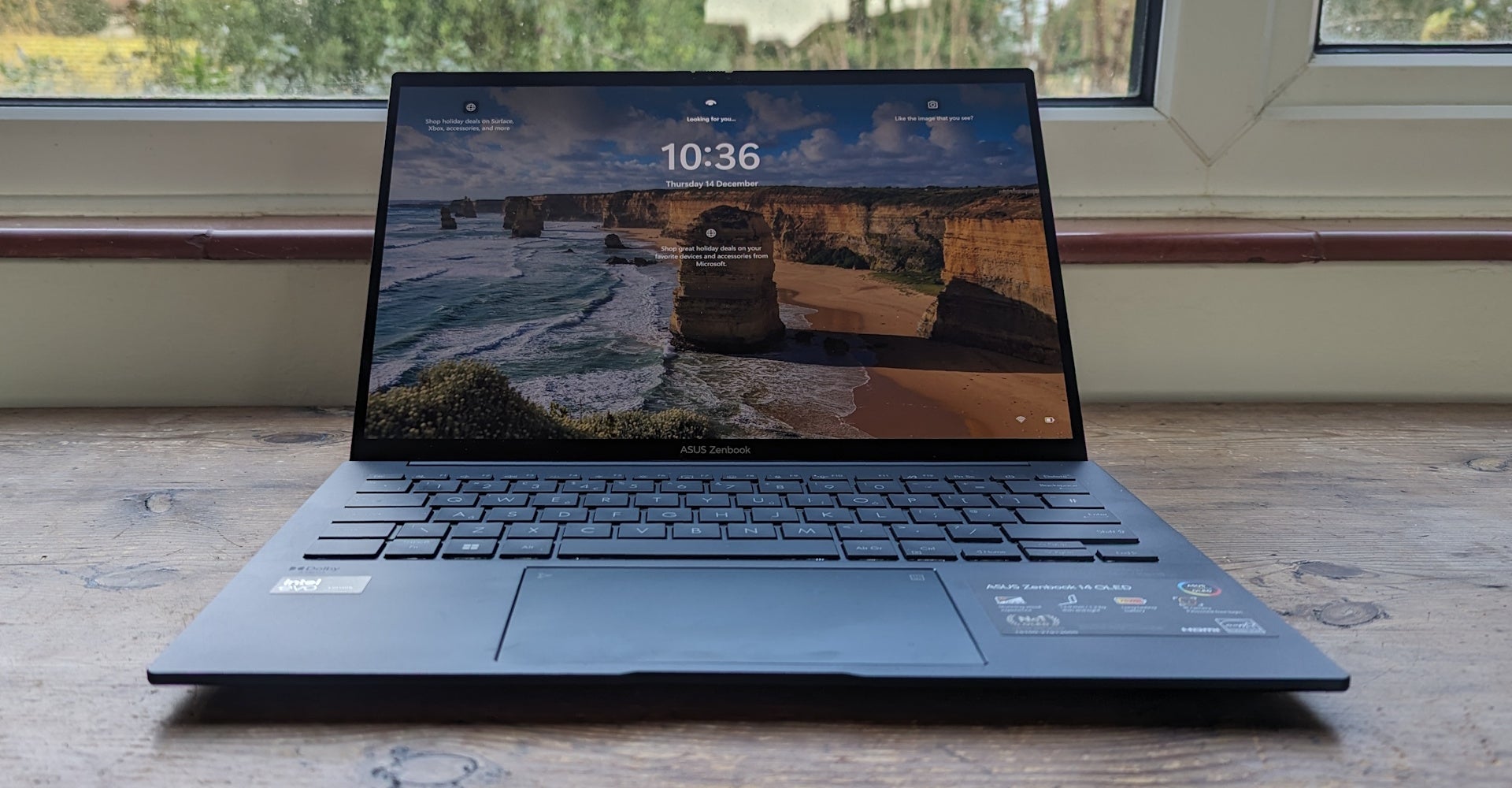
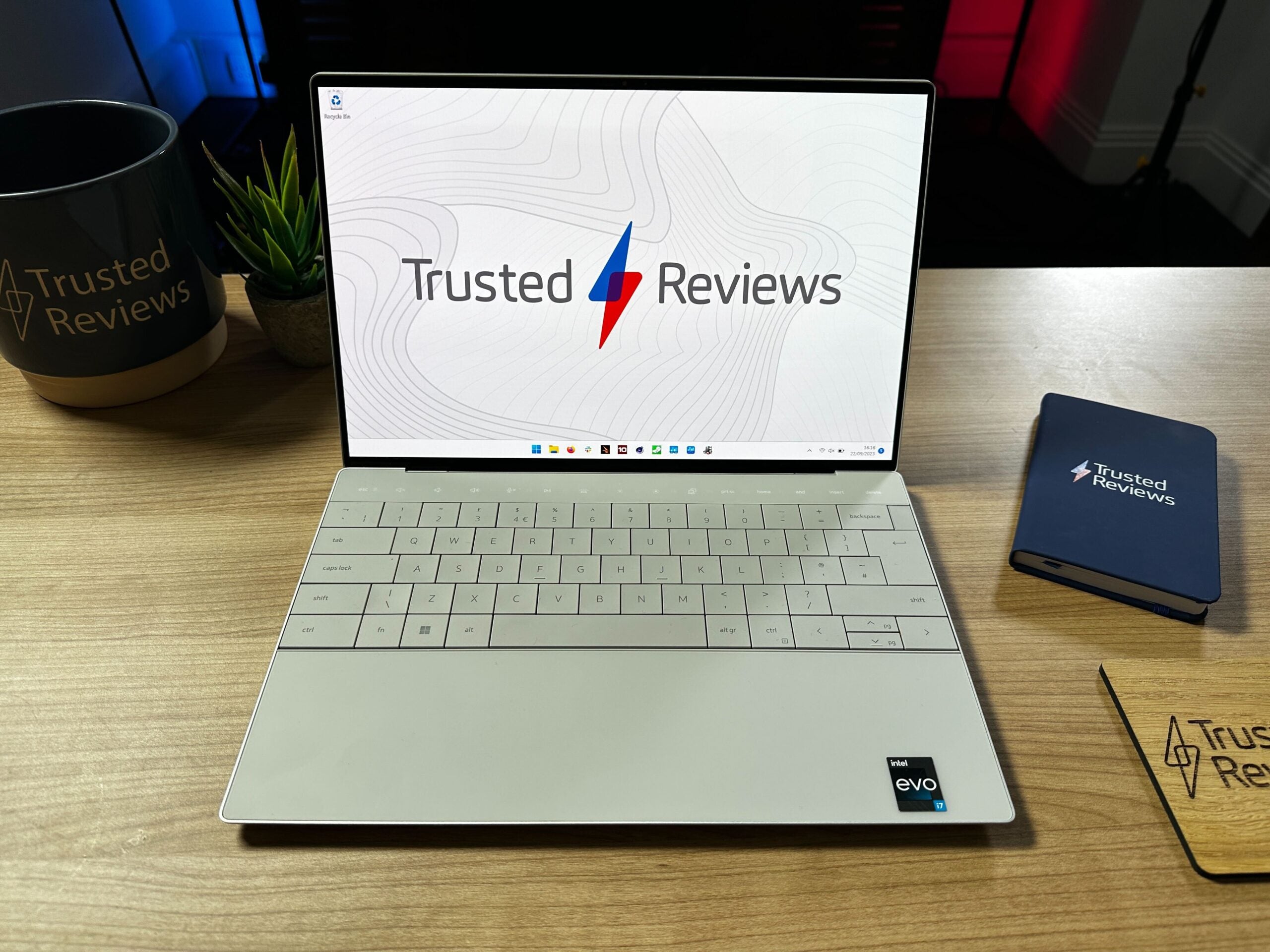
The audio is good given the Zenbook’s slim frame. Volume levels go high enough for casual listening without breaking up, and it’s only past the two-thirds mark that it starts to sound harsh and slightly booming. Up until that point, clarity is good with some decent positioning of stereo effects. If you use this laptop for voice calls and video meetings, you won’t have any issues hearing or being heard, and the front-facing 1080p webcam is also up to the task, delivering clear, bright, well-exposed video. As a bonus, it utilises Windows AI-powered Studio Effects to enhance video conferencing with background blur, eye contact, automatic framing and voice focus. You get an infrared depth sensor too, giving you password-free sign-in through Windows Hello.
Performance
- Core 7 Ultra is a real improvement on the previous generation Core i7
- New Intel Arc GPU crushes previous Intel efforts and competes with AMD’s best
- Still not enough GPU performance for the most demanding AAA titles at 1080p
With 6 P-cores and 10 E-cores running a total of 22 threads at speeds of up to 4.8GHz, the Core Ultra 7 155H is, on paper, something of a powerhouse. To put that in perspective, it has two more P-cores and two more E-cores than its 13th-gen equivalent, the Core i7-1360P, not to mention the new NPU and Arc GPU. The i7-1360P had a higher 5GHz boost on the P-cores, but the E-cores maxed out at 3.7GHz rather than the 3.8GHz of the Ultra 7 155H. Throw in the I/O advantages of the new tile architecture, and it’s safe to expect big things from Meteor Lake laptops.
And the Asus Zenbook 14 OLED sort of delivers on that promise. Our £1,399.99 review model sports that Core Ultra 7 155H chip alongside 32GB RAM and 1TB SSD. Its Geekbench 6 scores of 2352 (single-core) and 12425 (multi-core) put it ahead of i7-1360P laptops like the Dell XPS 13 Plus (2023) and LG Gram SuperSlim, though the LG is slightly ahead on single-threaded performance. In PC Mark 10, the Zenbook 14 OLED scores 6279 overall, against 5738 from the LG Gram SuperSlim and 5082 from the Dell XPS 13 Plus. In the 3DMark Time Spy test, there’s no comparison, with the Asus scoring 2730 to 1829 from the Dell and 1738 from the LG.
Throw more ambitious workloads at the Zenbook 14 OLED and it still comes up trumps. In Cinebench R23 it scores 1669 (single-core) and 9515 (multi-core), against 1552 and 8663 from the Dell and 1690 and 7083 from the LG. It also scored 56.32, 33.07 and 21.81 in the three test scenarios of the Blender 4.0 benchmark.
However, the Asus Zenbook 14 OLED faces stiffer competition from devices running AMD’s 7000-series APUs. For instance, its close cousin, the Asus Zenbook 15 OLED, uses a Ryzen 7 7735U, and while it’s slower in the Geekbench benchmarks it’s faster in PC Mark 10, scoring 6480. The Core 7 Ultra’s Arc GPU crushes the Ryzen 7’s Radeon 680M GPU in 3DMark, but it might not fare so well against newer APUs with the Radeon 780M, which tends to score around 2890 to 2950 in the Time Spy test.
As with the Radeon 780M, you need to be realistic about what this means for gaming. Gaming at the 1800p native resolution is out of the picture, and even at 1440p you’ll be looking at unplayable 14fps frame rates in Returnal at the highest detail settings. Switch down to 1080p and medium settings, then use XESS resolution scaling, and you can push that up to an almost playable 29fps, but you need to dip to Low and even 720p to get a smooth result. Cyberpunk 2077 is even rougher. Even at a 1080p resolution with XeSS enabled and the Medium preset, I could only just scrape over 30fps. You’ll either have to drop the resolution or the detail setting if you want a truly playable experience.
If that’s not something you can live with, you’re advised to pick less ambitious titles. Rainbow Six: Extraction runs at 50fps at 1080p with Ultra settings, or 66fps if you switch that down to Medium.
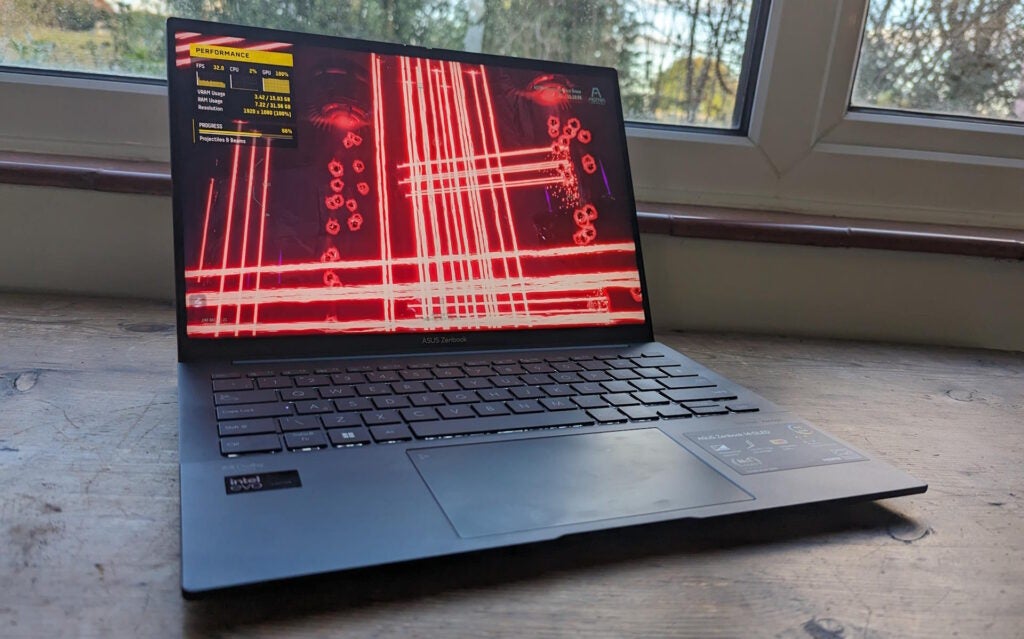
Is this just a little disappointing for the Core 7 Ultra 155H? Maybe, but I suspect that the Zenbook 14 OLED’s design and cooling are also a factor. For one thing, by switching the fan profile from Balanced to Performance, I could push the Time Spy result from 2730 to 3324 at the expense of extra fan noise, though the Cinebench and Geekbench scores didn’t improve.
For another, I received a Core 7 Ultra 155H device from Acer with a similar spec during testing, and it’s substantially faster across our benchmark suite, scoring 6705 in PC Mark 10, 3535 in 3D Mark Time Spy and 1742 and 11880 in Cinebench R23. And while I haven’t run the full set of gaming benchmarks, it was faster in Returnal, scoring 33fps with Medium settings and XESS at 1080p, and also Rainbow Six Extraction, where I saw 67fps with Ultra settings at 1080p. The Acer is a bigger, noisier laptop, but it’s pulling out some extra speed.
Games aside, though, the Core 7 Ultra does pretty much what you might hope; delivering faster performance for creative apps and improved 3D performance even when used inside a slim and light device. I’m not suggesting that the Zenbook 14 OLED makes the ideal ultramobile graphics workstation, but it’s perfectly capable of handling mainstream workloads in Photoshop, Vegas Pro, Adobe Premiere and more.
Software
- Not too much in the way of unwanted bloatware
- Asus utilities add some value, especially if you use an Android tablet or phone
The Zenbook 14 OLED comes with a range of software pre-installed, including a trial of McAfee LiveSafe and Asus’s own MyAsus, Screen Xpert and GlideX utilities. The latter provides access to settings and performance profiles, though it’s got a nasty habit of throwing up prompts to upsell you to extended warranties and other service upgrades. GlideX is basically a screen-sharing tool, enabling you to run apps from your Android smartphone on your laptop screen or extend your laptop display onto a tablet screen. Screen Xpert, meanwhile, is a utility for managing apps across multiple desktops, with a handful of options you won’t find baked into Windows. All are vaguely useful, if not exactly essential, and there’s relatively little bloatware pre-installed.
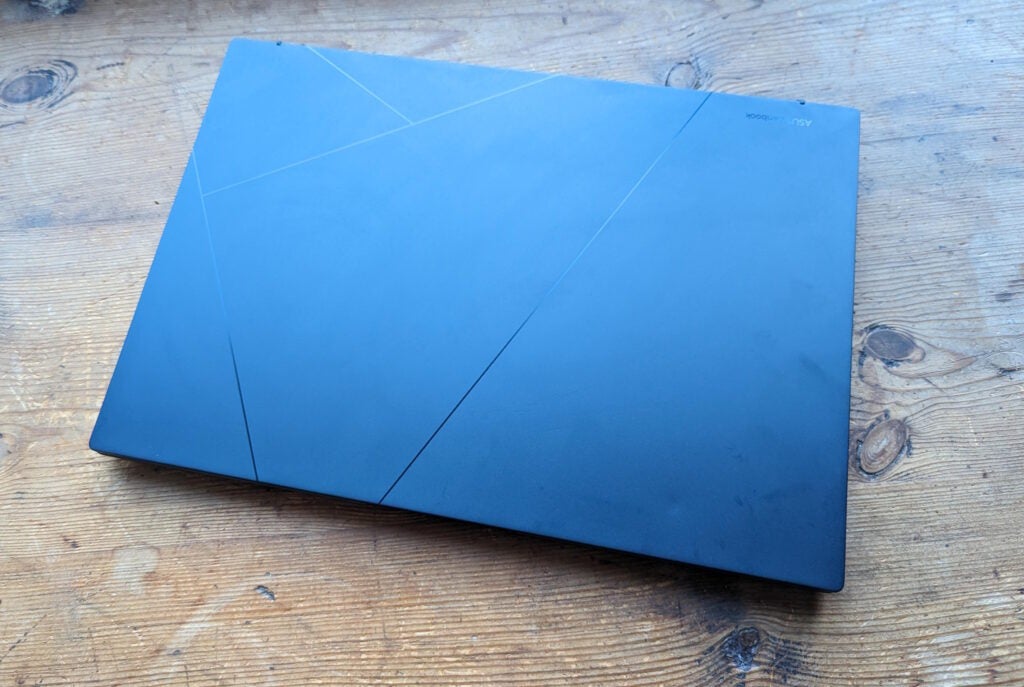
Battery life
- Nearly 13 hours of battery life in the Modern Office benchmark
- An hour of streaming Netflix at full brightness can see the battery go down by 17%
The Asus Zenbook 14 OLED impresses when it comes to battery life, lasting 12 hours and 56 minutes in PC Mark 10’s Modern Office battery benchmark, putting it in roughly the same league as the LG Gram SuperSlim and the Samsung Galaxy Book 3 360. In practice, I never had any problems making it through a working day before recharging. When streaming video at full brightness, you can expect the battery to go down by roughly 17% in an hour.
Latest deals
Should you buy it?
You need an ultraportable with next-gen power
The Zenbook 14 OLED isn’t the most powerful Meteor Lake device, but it demonstrates the potential of Intel’s new CPUs for delivering desktop-class performance in a lightweight form factor. It’s a great laptop with an excellent OLED screen and can handle any mainstream workload.
You want to go bigger on GPU performance
The Core 7 Ultra offers a higher level of 3D performance than any previous Intel CPU with an integrated GPU. All the same, it can’t match the power of even the cheaper dedicated GPUs, while speeds are to some degree constrained by the thin and light design.
Final Thoughts
With its thin and light design, the Asus Zenbook 14 OLED can’t quite show off the full potential of Intel’s new Core 7 Ultra CPU, but it makes a great demonstration of how the new architecture is enabling manufacturers to reach higher levels of performance from an ultraportable device. It comfortably tops similar devices from the previous generation, like the Dell XPS 13 Plus (2023), and even larger ones, like the Asus Zenbook 15 OLED and LG Gram SuperSlim.
In fact, with its fantastic OLED screen and comfortable ergonomics, the Asus could work as a creator’s laptop or a business machine, or just about anything else bar a full-blooded gaming PC. Here the new Arc iGPU is a huge improvement on Intel’s earlier integrated graphics tech – and serious competition for AMD’s fastest APUs in the likes of the Acer Swift Edge 16 – but still not in the same league as dedicated hardware. If you want more gaming capabilities, you’ll need to look for something bigger, heavier and faster, but this is a brilliant and versatile ultraportable for everyone else.
The Asus Zenbook 14 OLED marks a step forward for Intel thin-and-light laptops, making high-end productivity and strong creator capabilities a reality in a surprisingly unassuming footprint. The price isn’t disappointingly high either, with the Core Ultra 7 model I tested coming in at £1,399.99 and the range starting at £1,099.99 overall. It’s MacBook Air money and this is a worthy rival.
How we test
Every laptop we review goes through a series of uniform checks designed to gauge key things including build quality, performance, screen quality and battery life.
These include formal synthetic benchmarks and scripted tests, plus a series of real world checks.
We used as our main laptop for at least a week.
Tested the performance via both benchmark tests and real-world use.
We tested the screen with a colorimeter and real-world use.
We tested the battery with a benchmark test and real-world use.
FAQs
The short answer is no, as this laptop is not for gaming. However, you can dabble in low-demand games.
Trusted Reviews test data
PCMark 10
Cinebench R23 multi core
Cinebench R23 single core
Geekbench 6 single core
Geekbench 6 multi core
3DMark Time Spy
CrystalDiskMark Read speed
CrystalDiskMark Write Speed
Brightness (SDR)
Black level
Contrast ratio
White Visual Colour Temperature
sRGB
Adobe RGB
DCI-P3
PCMark Battery (office)
Battery discharge after 60 minutes of online Netflix playback
Cyberpunk 2077 (Quad HD)
Cyberpunk 2077 (Full HD)
Cyberpunk 2077 (Full HD + Supersampling)
Returnal (Quad HD)
Returnal (Full HD)
Verdict
A fantastic lightweight laptop combining good design, strong performance and an excellent screen. It’s a promising first showcase for Intel’s new Core Ultra range.
Pros
- Great performance in mainstream apps
- Good gaming performance by iGPU standards
- Fantastic OLED screen
- No compromises on the connectivity or ergonomics
Cons
- GPU speeds constrained by slimline form factor
-
High performance in a slim-and-light designIntel’s new Meteor Lake architecture brings higher levels of CPU and GPU performance to ultraportable devices. -
Better graphics from an iGPUWith an Intel Arc GPU on its own tile within the processor, this is the first Intel laptop to deliver gaming-grade performance without a dedicated graphics chip. -
Superb OLED displayWith a high 1800p resolution and brilliant colour reproduction, this OLED screen is perfect for creative applications – or even just games and streaming video.
Introduction
Intel’s Meteor Lake technology is a big deal. Sure, we’ve had some big changes in the last few processor generations, particularly the introduction of Performance and Efficient cores in the 12th-generation Alder Lake CPUs, but Meteor Lake is a real departure from the Intel Core processors we’ve been seeing over the last 14 years. The Asus Zenbook 14 OLED is one of the first laptops to don the new Intel Core Ultra chips.
Not only does it ditch the single monolithic die for a fusion of tiles or chipsets, each covering different functions, but it’s the first Intel architecture to include a neural processing unit (NPU) for accelerating AI workloads, plus a dedicated graphics tile with a dedicated Intel Arc GPU. In doing so, Intel hopes to move away from previous processor families where the focus was all about multi-core CPU performance, and towards a more balanced architecture that can handle more demanding AI and graphics workloads within tighter power budgets and thermal requirements.
With its Core Ultra 7 155H CPU, the new Asus Zenbook 14 OLED is a case in point. This is a slimline 14-inch laptop, about as light and portable as such things get, yet with its 16-core, 22-thread CPU and integrated Arc Xe-LPG integrated GPU it can deliver the kind of performance you need to run demanding creative apps and even games at lower resolutions and detail settings. Pleasingly, Intel hasn’t jacked up the price for this exciting new generation either, with this laptop starting at £1,099.99 for the Core Ultra 5 model and up to £1,399.99 for a Core Ultra 9 specification – with my Core Ultra 7 review model sitting towards the higher end of the middle.
In recent years, buying an Intel-based laptop of this kind without a dedicated GPU has meant accepting compromises around multi-threaded or graphics performance beyond those you’d make using AMD’s APUs or Apple’s Silicon processors. With Meteor Lake, that could be a thing of the past.
Design and Keyboard
- Thin and light design with tough aluminium chassis
- Solid selection of ports and sockets plus Wi-Fi 6E connectivity
- Great keyboard with crisp, clicky action
If you’ve seen previous Asus Zenbook 14 OLED models, you won’t find anything too surprising about this update’s design. It’s a slim 15mm thick unit, barely bigger than its 14-inch OLED screen at 312 x 220mm, and it weighs just 1.29 kg. The casing is an aluminium alloy coated in an attractive, ceramic feel ink-blue finish, and its MIL-STD-810H certified for durability. There’s barely any flex anywhere in the chassis, including the lid, and I can’t imagine it struggling with a life of being stashed in bags and sitting on coffee shop tables. The lid, with its origami fold design, looks great.
Closed, right side view of the Asus Zenbook 14 OLED
Open, right side view of the Asus Zenbook 14 OLED
Open, left side view of the Asus Zenbook 14 OLED
Closed, left side view of the Asus Zenbook 14 OLED
Connectivity is pretty good for such a slimline unit. Given that it charges via USB Type-C, I’d like to see ports on both sides of the laptop rather than two Thunderbolt 4/USB Type-C ports on the right, but you also get a USB 3.2 Gen 1 Type-A port on the left and an HDMI 2.1 output on the right. Right next door, you’ll find the traditional 3.5mm audio socket. Unlike previous generations, there’s no micro SD card slot.
The Zenbook line tends to squeeze decent ergonomics from compact designs, and the new Zenbook 14 OLED carries on the good work. The backlit keyboard makes the most of the space available, with normal-sized, flat-topped keys in a standard layout, with a little shrinkage on the left Shift and Ctrl keys and a weirdly oversized hash key, but nothing that’s interrupted the flow of my typing in any way. The keys don’t wobble under pressure and the action feels tight with a nice, subtle click. The slim design makes it easy to find a comfortable typing position.

I’ve got plenty of time for the touchpad, too. It feels as smooth as glass, tracking is nigh-on flawless, and it’s big enough to handle some fairly fast or precise work. I’m not such a huge fan of Asus’s NumberPad feature, which transforms the touchpad into a numeric keypad when you touch and hold the symbol in the top-right – I occasionally turn it on by accident and wonder why I keep getting rogue numbers turning up in online forms. Still, it’s easy enough to disable it again when it does.

Bar the use of post-consumer recycled plastics in the few areas where plastics are visible, there’s not much of a focus on sustainability with this specific model. However, the packaging is mostly cardboard, so at least that shouldn’t be ending up in landfill.
Display and Sound
- Bright 14in OLED panel with 2880 x 1800 resolution and 120Hz refresh
- Superb contrast and colour reproduction for HDR video and more
- Decent audio at lower volume levels, but loses clarity as the volume goes up
If it weren’t for the next-gen CPU, the display would be the highlight of the Asus Zenbook 14 OLED. It’s a 14-inch OLED panel with a 2880 x 1800 resolution and a 120Hz refresh, and it’s beautifully crisp and vibrant. Colours have a zing you won’t see on most IPS displays, while HDR games and videos look fantastic.

With a colorimeter, I measured SDR brightness levels at 417.2nits, which is bright enough for use anywhere away from direct sunlight, while contrast is technically infinity:1. As for colour reproduction, the screen covers 100% of sRGB, 99.9% of DCI-P3 and 97.6% of Adobe RGB, with volumes of 172.8%, 122% and 119% respectively. In short, it’s more than good enough for high-end video, image-editing and design applications, particularly as colour accuracy is outstanding, with an average Delta-E of just 0.89.


The audio is good given the Zenbook’s slim frame. Volume levels go high enough for casual listening without breaking up, and it’s only past the two-thirds mark that it starts to sound harsh and slightly booming. Up until that point, clarity is good with some decent positioning of stereo effects. If you use this laptop for voice calls and video meetings, you won’t have any issues hearing or being heard, and the front-facing 1080p webcam is also up to the task, delivering clear, bright, well-exposed video. As a bonus, it utilises Windows AI-powered Studio Effects to enhance video conferencing with background blur, eye contact, automatic framing and voice focus. You get an infrared depth sensor too, giving you password-free sign-in through Windows Hello.
Performance
- Core 7 Ultra is a real improvement on the previous generation Core i7
- New Intel Arc GPU crushes previous Intel efforts and competes with AMD’s best
- Still not enough GPU performance for the most demanding AAA titles at 1080p
With 6 P-cores and 10 E-cores running a total of 22 threads at speeds of up to 4.8GHz, the Core Ultra 7 155H is, on paper, something of a powerhouse. To put that in perspective, it has two more P-cores and two more E-cores than its 13th-gen equivalent, the Core i7-1360P, not to mention the new NPU and Arc GPU. The i7-1360P had a higher 5GHz boost on the P-cores, but the E-cores maxed out at 3.7GHz rather than the 3.8GHz of the Ultra 7 155H. Throw in the I/O advantages of the new tile architecture, and it’s safe to expect big things from Meteor Lake laptops.
And the Asus Zenbook 14 OLED sort of delivers on that promise. Our £1,399.99 review model sports that Core Ultra 7 155H chip alongside 32GB RAM and 1TB SSD. Its Geekbench 6 scores of 2352 (single-core) and 12425 (multi-core) put it ahead of i7-1360P laptops like the Dell XPS 13 Plus (2023) and LG Gram SuperSlim, though the LG is slightly ahead on single-threaded performance. In PC Mark 10, the Zenbook 14 OLED scores 6279 overall, against 5738 from the LG Gram SuperSlim and 5082 from the Dell XPS 13 Plus. In the 3DMark Time Spy test, there’s no comparison, with the Asus scoring 2730 to 1829 from the Dell and 1738 from the LG.
Throw more ambitious workloads at the Zenbook 14 OLED and it still comes up trumps. In Cinebench R23 it scores 1669 (single-core) and 9515 (multi-core), against 1552 and 8663 from the Dell and 1690 and 7083 from the LG. It also scored 56.32, 33.07 and 21.81 in the three test scenarios of the Blender 4.0 benchmark.
However, the Asus Zenbook 14 OLED faces stiffer competition from devices running AMD’s 7000-series APUs. For instance, its close cousin, the Asus Zenbook 15 OLED, uses a Ryzen 7 7735U, and while it’s slower in the Geekbench benchmarks it’s faster in PC Mark 10, scoring 6480. The Core 7 Ultra’s Arc GPU crushes the Ryzen 7’s Radeon 680M GPU in 3DMark, but it might not fare so well against newer APUs with the Radeon 780M, which tends to score around 2890 to 2950 in the Time Spy test.
As with the Radeon 780M, you need to be realistic about what this means for gaming. Gaming at the 1800p native resolution is out of the picture, and even at 1440p you’ll be looking at unplayable 14fps frame rates in Returnal at the highest detail settings. Switch down to 1080p and medium settings, then use XESS resolution scaling, and you can push that up to an almost playable 29fps, but you need to dip to Low and even 720p to get a smooth result. Cyberpunk 2077 is even rougher. Even at a 1080p resolution with XeSS enabled and the Medium preset, I could only just scrape over 30fps. You’ll either have to drop the resolution or the detail setting if you want a truly playable experience.
If that’s not something you can live with, you’re advised to pick less ambitious titles. Rainbow Six: Extraction runs at 50fps at 1080p with Ultra settings, or 66fps if you switch that down to Medium.

Is this just a little disappointing for the Core 7 Ultra 155H? Maybe, but I suspect that the Zenbook 14 OLED’s design and cooling are also a factor. For one thing, by switching the fan profile from Balanced to Performance, I could push the Time Spy result from 2730 to 3324 at the expense of extra fan noise, though the Cinebench and Geekbench scores didn’t improve.
For another, I received a Core 7 Ultra 155H device from Acer with a similar spec during testing, and it’s substantially faster across our benchmark suite, scoring 6705 in PC Mark 10, 3535 in 3D Mark Time Spy and 1742 and 11880 in Cinebench R23. And while I haven’t run the full set of gaming benchmarks, it was faster in Returnal, scoring 33fps with Medium settings and XESS at 1080p, and also Rainbow Six Extraction, where I saw 67fps with Ultra settings at 1080p. The Acer is a bigger, noisier laptop, but it’s pulling out some extra speed.
Games aside, though, the Core 7 Ultra does pretty much what you might hope; delivering faster performance for creative apps and improved 3D performance even when used inside a slim and light device. I’m not suggesting that the Zenbook 14 OLED makes the ideal ultramobile graphics workstation, but it’s perfectly capable of handling mainstream workloads in Photoshop, Vegas Pro, Adobe Premiere and more.
Software
- Not too much in the way of unwanted bloatware
- Asus utilities add some value, especially if you use an Android tablet or phone
The Zenbook 14 OLED comes with a range of software pre-installed, including a trial of McAfee LiveSafe and Asus’s own MyAsus, Screen Xpert and GlideX utilities. The latter provides access to settings and performance profiles, though it’s got a nasty habit of throwing up prompts to upsell you to extended warranties and other service upgrades. GlideX is basically a screen-sharing tool, enabling you to run apps from your Android smartphone on your laptop screen or extend your laptop display onto a tablet screen. Screen Xpert, meanwhile, is a utility for managing apps across multiple desktops, with a handful of options you won’t find baked into Windows. All are vaguely useful, if not exactly essential, and there’s relatively little bloatware pre-installed.

Battery life
- Nearly 13 hours of battery life in the Modern Office benchmark
- An hour of streaming Netflix at full brightness can see the battery go down by 17%
The Asus Zenbook 14 OLED impresses when it comes to battery life, lasting 12 hours and 56 minutes in PC Mark 10’s Modern Office battery benchmark, putting it in roughly the same league as the LG Gram SuperSlim and the Samsung Galaxy Book 3 360. In practice, I never had any problems making it through a working day before recharging. When streaming video at full brightness, you can expect the battery to go down by roughly 17% in an hour.
Latest deals
Should you buy it?
You need an ultraportable with next-gen power
The Zenbook 14 OLED isn’t the most powerful Meteor Lake device, but it demonstrates the potential of Intel’s new CPUs for delivering desktop-class performance in a lightweight form factor. It’s a great laptop with an excellent OLED screen and can handle any mainstream workload.
You want to go bigger on GPU performance
The Core 7 Ultra offers a higher level of 3D performance than any previous Intel CPU with an integrated GPU. All the same, it can’t match the power of even the cheaper dedicated GPUs, while speeds are to some degree constrained by the thin and light design.
Final Thoughts
With its thin and light design, the Asus Zenbook 14 OLED can’t quite show off the full potential of Intel’s new Core 7 Ultra CPU, but it makes a great demonstration of how the new architecture is enabling manufacturers to reach higher levels of performance from an ultraportable device. It comfortably tops similar devices from the previous generation, like the Dell XPS 13 Plus (2023), and even larger ones, like the Asus Zenbook 15 OLED and LG Gram SuperSlim.
In fact, with its fantastic OLED screen and comfortable ergonomics, the Asus could work as a creator’s laptop or a business machine, or just about anything else bar a full-blooded gaming PC. Here the new Arc iGPU is a huge improvement on Intel’s earlier integrated graphics tech – and serious competition for AMD’s fastest APUs in the likes of the Acer Swift Edge 16 – but still not in the same league as dedicated hardware. If you want more gaming capabilities, you’ll need to look for something bigger, heavier and faster, but this is a brilliant and versatile ultraportable for everyone else.
The Asus Zenbook 14 OLED marks a step forward for Intel thin-and-light laptops, making high-end productivity and strong creator capabilities a reality in a surprisingly unassuming footprint. The price isn’t disappointingly high either, with the Core Ultra 7 model I tested coming in at £1,399.99 and the range starting at £1,099.99 overall. It’s MacBook Air money and this is a worthy rival.
How we test
Every laptop we review goes through a series of uniform checks designed to gauge key things including build quality, performance, screen quality and battery life.
These include formal synthetic benchmarks and scripted tests, plus a series of real world checks.
We used as our main laptop for at least a week.
Tested the performance via both benchmark tests and real-world use.
We tested the screen with a colorimeter and real-world use.
We tested the battery with a benchmark test and real-world use.
FAQs
The short answer is no, as this laptop is not for gaming. However, you can dabble in low-demand games.
Trusted Reviews test data
PCMark 10
Cinebench R23 multi core
Cinebench R23 single core
Geekbench 6 single core
Geekbench 6 multi core
3DMark Time Spy
CrystalDiskMark Read speed
CrystalDiskMark Write Speed
Brightness (SDR)
Black level
Contrast ratio
White Visual Colour Temperature
sRGB
Adobe RGB
DCI-P3
PCMark Battery (office)
Battery discharge after 60 minutes of online Netflix playback
Cyberpunk 2077 (Quad HD)
Cyberpunk 2077 (Full HD)
Cyberpunk 2077 (Full HD + Supersampling)
Returnal (Quad HD)
Returnal (Full HD)


















